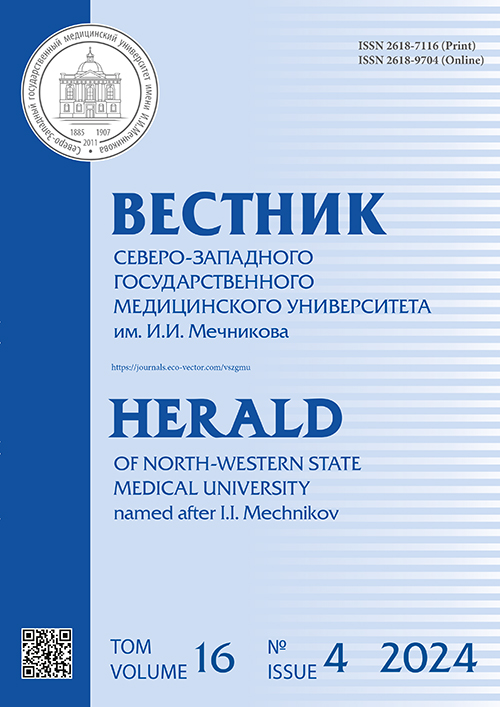The applicability of cardiopulmonary exercise testing of young obese adults
- 作者: Kelekhsaev P.A.1,2, Varaeva Y.R.2, Kislyak O.A.1, Starodubova A.V.1,2
-
隶属关系:
- Pirogov Russian National Research Medical University
- Federal Research Center of Nutrition, Biotechnology and Food Safety
- 期: 卷 16, 编号 4 (2024)
- 页面: 126-133
- 栏目: Original study article
- ##submission.dateSubmitted##: 13.07.2024
- ##submission.dateAccepted##: 15.08.2024
- ##submission.datePublished##: 20.12.2024
- URL: https://journals.eco-vector.com/vszgmu/article/view/634273
- DOI: https://doi.org/10.17816/mechnikov634273
- ID: 634273
如何引用文章
详细
BACKGROUND: Obesity is an independent risk factor for cardiovascular disease. In this regard, the early detection of cardio-vascular disfunction among young adults is an important issue. This problem can be solved by the cardiopulmonary exercise testing.
AIM: The aim of this study is to determine the applicability of cardiopulmonary exercise testing to assess the functional cardiovascular state in young and obese adults.
MATERIALS AND METHODS: 84 young participants (18–44 years), 39% men, underwent a comprehensive examination including anthropometry, spirometry and cardiopulmonary exercise testing using a graded protocol in the period 2021–2022. Four groups of cardiopulmonary exercise testing indicators were assessed: metabolic, cardiovascular, ventilatory and pulmonary gas exchange parameters.
RESULTS: 35 participants (42%) were obese, 36 participants (43%) were smokers. The obesity had a negative impact on cardiovascular parameters of cardiopulmonary exercise testing: relative oxygen pulse on maximum load (60% vs. 72%, p = 0.004), heart rate on maximum load (86% vs. 90%, p = 0.024), maximum systolic blood pressure (181 mmHg vs. 156 mmHg, p < 0.001) and maximum diastolic blood pressure (92 mmHg vs. 83 mmHg, p = 0.040).
CONCLUSIONS: Cardiopulmonary exercise testing, especially assessing cardiovascular parameters, in young adults is in high practical interest for the functional cardiovascular status examination of individuals with obesity, smokers, and, particularly, in the case of their combination.
全文:
作者简介
Petr Kelekhsaev
Pirogov Russian National Research Medical University; Federal Research Center of Nutrition, Biotechnology and Food Safety
编辑信件的主要联系方式.
Email: kelehsaevp@gmail.com
ORCID iD: 0000-0003-1167-7503
SPIN 代码: 3502-7711
俄罗斯联邦, Moscow; Moscow
Yurgita Varaeva
Federal Research Center of Nutrition, Biotechnology and Food Safety
Email: yurgitavaraeva@gmail.com
ORCID iD: 0000-0002-5274-2773
SPIN 代码: 5825-5778
俄罗斯联邦, Moscow
Oxana Kislyak
Pirogov Russian National Research Medical University
Email: kisliakoa@mail.ru
ORCID iD: 0000-0002-2028-8748
MD, Dr. Sci. (Medicine)
俄罗斯联邦, MoscowAntonina Starodubova
Pirogov Russian National Research Medical University; Federal Research Center of Nutrition, Biotechnology and Food Safety
Email: avs.ion@yandex.ru
ORCID iD: 0000-0001-9262-9233
SPIN 代码: 3538-6196
MD, Dr. Sci. (Medicine)
俄罗斯联邦, Moscow; Moscow参考
- World Health Organization. WHO acceleration plan to stop obesity. World Health Organization. 2023. 20 p. [cited 2024 Dec 13]. Available from: https://www.who.int/publications/i/item/9789240075634
- Martinchik AN, Laikam KE, Kozyreva NA, et al. The prevalence of obesity in various socio-demographic groups of the population of Russia. Problems of Nutrition. 2021;90(3):67–76. EDN: LELEYO doi: 10.33029/0042-8833-2021-90-3-67-76
- Blüher M. Metabolically healthy obesity. Endocr Rev. 2020;41(3):bnaa004. doi: 10.1210/endrev/bnaa004
- Dwivedi AK, Dubey P, Cistola DP, Reddy SY. Association between obesity and cardiovascular outcomes: updated evidence from meta-analysis studies. Curr Cardiol Rep. 2020;22(4):25. doi: 10.1007/s11886-020-1273-y
- Cauwenberghs N, Sente J, Van Criekinge H, et al. Integrative interpretation of cardiopulmonary exercise tests for cardiovascular outcome prediction: a machine learning approach. Diagnostics (Basel). 2023;13(12):2051. doi: 10.3390/diagnostics13122051
- Glaab T, Taube C. Practical guide to cardiopulmonary exercise testing in adults. Respir Res. 2022;23(1):9. doi: 10.1186/s12931-021-01895-6
- Neder JA. Cardiopulmonary exercise testing applied to respiratory medicine: Myths and facts. Respir Med. 2023;214:107249. doi: 10.1016/j.rmed.2023.107249
- Mazaheri R, Schmied C, Niederseer D, Guazzi M. Cardiopulmonary exercise test parameters in athletic population: A review. J Clin Med. 2021;10(21):5073. doi: 10.3390/jcm10215073
- Lim ZX, Gyanwali B, Soh J, et al. The potential benefits of assessing post-cardiopulmonary exercise testing (CPET) in aging: a narrative review. BMC Sports Sci Med Rehabil. 2023;15(1):68. doi: 10.1186/s13102-023-00671-x
- Piepoli MF, Corrà U, Agostoni P. Cardiopulmonary exercise testing in patients with heart failure with specific comorbidities. Ann Am Thorac Soc. 2017;14(S1):S110–S115. doi: 10.1513/AnnalsATS.201610-803FR
补充文件







